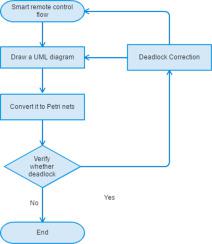当前位置:
X-MOL 学术
›
Comput. Electr. Eng.
›
论文详情
Our official English website, www.x-mol.net, welcomes your
feedback! (Note: you will need to create a separate account there.)
Development and verification of a smart remote control system for home appliances
Computers & Electrical Engineering ( IF 4.0 ) Pub Date : 2020-12-01 , DOI: 10.1016/j.compeleceng.2020.106889 Yi-Nan Lin , Sheng-Kuan Wang , Cheng-Ying Yang , Victor R.L. Shen , Tony Tong-Ying Juang , Wen-Hao Hung
Computers & Electrical Engineering ( IF 4.0 ) Pub Date : 2020-12-01 , DOI: 10.1016/j.compeleceng.2020.106889 Yi-Nan Lin , Sheng-Kuan Wang , Cheng-Ying Yang , Victor R.L. Shen , Tony Tong-Ying Juang , Wen-Hao Hung

|
Abstract People usually adopt a specific remote controller to monitor each home appliance, which is really inconvenient. In order to integrate different remote control functions into one software Application (App) on the smartphone, a smart remote control system is developed using the following two steps. The first step is to transform the designed operational flowchart of a smart remote control system into the Petri net model. It can avoid the potential hazards or vulnerabilities remained in the logically incorrect systems. Furthermore, through the deadlock verification, a deadlock can be prevented from the system design. The second step is to control home appliances remotely by using a smartphone with Bluetooth or WiFi network and sending commands to the infrared (IR) equipment. Finally, the experimental results have indicated that our daily life will become more convenient and safer when using a smartphone to control the home appliances remotely.
中文翻译:

一种家用电器智能遥控系统的开发与验证
摘要 人们通常采用特定的遥控器来监控每一个家用电器,这确实很不方便。为了将不同的遥控功能集成到智能手机上的一个软件应用程序(App)中,使用以下两个步骤开发智能遥控系统。第一步是将设计好的智能遥控系统操作流程图转化为Petri网模型。它可以避免在逻辑错误的系统中残留的潜在危害或漏洞。此外,通过死锁验证,可以防止系统设计出现死锁。第二步是通过使用具有蓝牙或WiFi网络的智能手机并向红外(IR)设备发送命令来远程控制家用电器。最后,
更新日期:2020-12-01
中文翻译:

一种家用电器智能遥控系统的开发与验证
摘要 人们通常采用特定的遥控器来监控每一个家用电器,这确实很不方便。为了将不同的遥控功能集成到智能手机上的一个软件应用程序(App)中,使用以下两个步骤开发智能遥控系统。第一步是将设计好的智能遥控系统操作流程图转化为Petri网模型。它可以避免在逻辑错误的系统中残留的潜在危害或漏洞。此外,通过死锁验证,可以防止系统设计出现死锁。第二步是通过使用具有蓝牙或WiFi网络的智能手机并向红外(IR)设备发送命令来远程控制家用电器。最后,











































 京公网安备 11010802027423号
京公网安备 11010802027423号